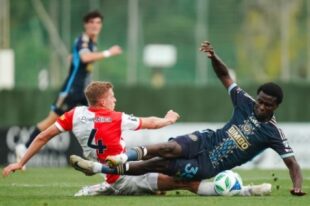Photo courtesy of the Philadelphia Union
Editor’s note: This piece is posted under my name. It was written however by my son, a soccer-obsessed 10-year-old who is named after Italian soccer royalty, has a wicked right-footed shot, and is a tactician heart, sporting a FUT squad to rival all comers.
The Philadelphia Union opened their 2025 campaign with a new look, playing a 4-2-2-2 formation. The 4-2-2-2, or four-triple-two, is certainly not the most common formation in soccer, but there are plenty of good things about it.
Under the right manager, it can be very useful.
Basic Shape
The 4-2-2-2 has four defenders, the left back, two center backs, and a right back. There are four midfielders: two defensive midfielders, and two attacking midfielders higher up and a little wider. Above the midfield is, of course, the attack. The attack consists of two strikers.
The fullbacks have a huge role to play, as they are the team’s only natural source of width. They have to go up and down the pitch, collecting wide passes on the attack and sprinting back to stop a counterattack.
The team needs two tough center backs to help thwart opposing breakaways since the fullbacks go very high on the attack, as happened many times on Saturday. This means that when Union lose the ball on offense, the center backs can be alone in trying to stop the opposition from scoring a goal.
The defensive midfielders are crucial in the buildup if the goalie kicks the ball short. They often position themselves between the lines to break the press. When attacking, they will commonly be used as support on the edge of the box, ready to collect any loose balls. It is not uncommon for one defensive midfielder to drop back between the center backs to create a back three, as the fullbacks will be very high up the field. This is so that if possession is lost, there are not just two lone center backs defending a whole attack.
The attacking midfielders can be used to create overloads out wide, or they can help make numbers in the box. They can drop back to receive the ball, or attack the space behind opposing lines. For this reason, they are usually the most creative players on the pitch, able to pick out a precise pass or dribble past an opponent.
The strikers mostly have two roles. One drops back to help the buildup and receive short passes. One becomes a target man, ready to get long balls or crosses launched at him. In the season opener, Mikael Uhre constantly dropped back into the midfield while Tai Baribo made a run behind the defense.
Changing the shape
This formation can turn into plenty of other formations too. If the midfielders rotate, you have a 4-1-2-1-2, or 4-4-2 diamond. If the attacking midfielders drop back and push out wide, you have a regular 4-4-2. If they instead become wingers beside the strikers, there is a 4-2-4.
The basic structure means that there are players staggered on different lines all up the pitch. The players are close together, meaning that the team using the formation will need to be good at their quick, short passes in the midfield. On Saturday, the Union certainly were.
When building from the back, the goalkeeper will always have a number of options to rely on. Firstly, having two strikers means that a long ball over the top can create danger. One striker could attack the ball, while the other runs into the space behind the defense.
When there are two attacking midfielders, the striker can lay the ball off to one of them, giving the team an advantage, as they are now facing the goal.
This formation can work in a lot of ways.
Conclusion
The Union have adopted a new formation this season, the 4-2-2-2. The basics of the formation, the roles of the players, and how the Union can use this shape are all outlined above. Some of these tactics were used by the Union in the game Saturday, some weren’t.
Union coach Bradley Carnell is not one to stick with a formation if it doesn’t work though. If he changes the formation this season, look for an update here.
For now, it’s the 4-2-2-2, and All3Points…
Editor’s note: Well played.


appreciate the breakdown. I didn’t watch Carnell before. it’ll be interesting to see his flexibility in-game when the formation isn’t working.
Great analysis, thanks very much!
Very nice !! And short and to the point! Not being a tactical expert, I found soccer later in life, your explanation is very helpful. I thought the U did a nice job of keeping possession and the using the occasional line breaking pass. The eye test says they have work to do to get the flow better. But for a first game look at the 4-2-2-2 I was pleasantly surprised with the overall play. Chris please pass along my gratitude to your son. Also I hope his team has a successful season!
Well done
This was actually quite helpful, thank you!